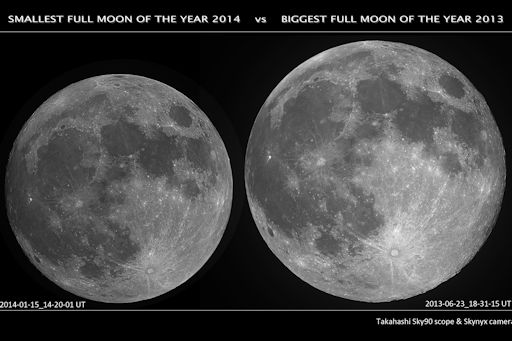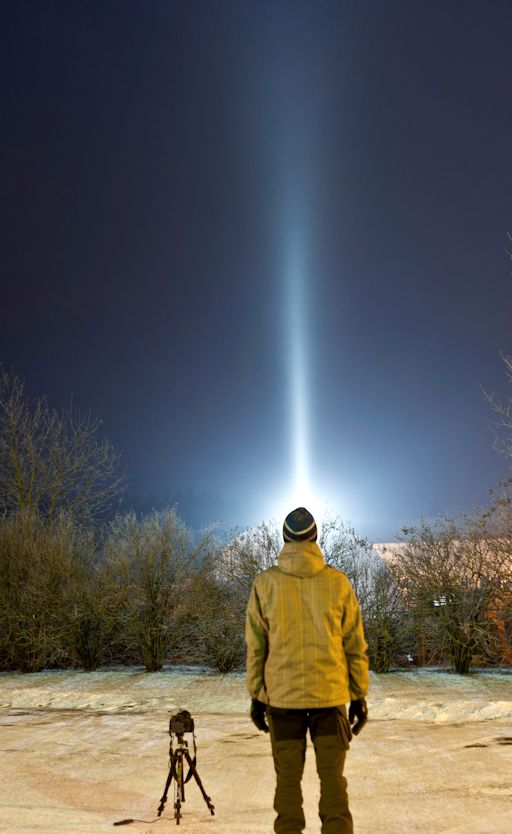CHANCE OF STORMS: NOAA forecasters estimate a 35% chance of polar geomagnetic storms on Jan. 17th when a minor CME is expected to hit Earth. High-latitude sky watchers should be alert for auroras competing with bright moonlight. Aurora alerts: text, voice.
SMALLEST FULL MOON OF THE YEAR: Last night's full Moon was the smallest of the year, as much as 14% smaller and 30% dimmer than other full Moons of 2014. But could you tell the difference? When the Moon is high in the sky with no reference points nearby, a big Moon and a small Moon look much the same. To set the scale of the phenomenon, Karzaman Ahmad of the Langkawi National Observatory in Maylasia photographed last night's Moon and placed it alongside a photo of the largest Moon from 2013:
"It really was smaller!" he says.
Full Moons vary in size and brightness because of the oval shape of the Moon's orbit. The Moon follows an elliptical path around Earth with one side ("perigee") about 50,000 km closer than the other ("apogee"). Last night's full Moon was a distant apogee Moon--less big and bright, but no less beautiful. Browse the gallery for more examples.
Realtime Space Weather Photo Gallery
LIGHT PILLARS: Winter is unfolding around the northern hemisphere. As temperatures drop, pillars of light are springing up from ground. Janis Satrovskis of Valmiera, Latvia, photographed this specimen on Jan. 14th:
Light pillars are a common sight around northern cities in winter. Urban lights bounce off ice crystals in the air, producing tall luminous columns sometimes mistaken for auroras. Usually the ice crystals are natural, such as snow flakes, but in this case the atmospheric optics were artificial.
"The amazing phenomenon was created by snow blowing machines," explains Satrovskis. "These are our first days with temperatures below zero and ski resorts are making snow. A slight breeze carried manmade snow over the city, creating a spectacular view."
Light pillars are springing up in cold cities around the world. Is yours one of them? Browse the gallery for the latest sightings.

Solar wind
speed: 396.8 km/sec
density: 2.3 protons/cm3
explanation | more data
Updated: Today at 1836 UT
X-ray Solar Flares
6-hr max: C2 1542 UT Jan16
24-hr: C2 1542 UT Jan16
explanation | more data
Updated: Today at: 1800 UT
![]()
Daily Sun: 16 Jan 14
None of the sunspots on the Earthside of the sun poses a threat for strong flares. Solar activity is low. Credit: SDO/HMI
![]()
Sunspot number: 87
What is the sunspot number?
Updated 16 Jan 2014
Spotless Days
Current Stretch: 0 days
2014 total: 0 days (0%)
2013 total: 0 days (0%)
2012 total: 0 days (0%)
2011 total: 2 days (<1%)
2010 total: 51 days (14%)
2009 total: 260 days (71%)
Update 16 Jan 2014
The Radio Sun
10.7 cm flux: 126 sfu
explanation | more data
Updated 16 Jan 2014
![]()
Current Auroral Oval:
Switch to: Europe, USA, New Zealand, Antarctica
Credit: NOAA/POES
![]()
Planetary K-index
Now: Kp= 0 quiet
24-hr max: Kp= 1 quiet
explanation | more data
Interplanetary Mag. Field
Btotal: 1.9 nT
Bz: 1.9 nT north
explanation | more data
Updated: Today at 1837 UT
![]()
Coronal Holes: 16 Jan 14
There are no large coronal holes on the Earthside of the sun. Credit: SDO/AI






